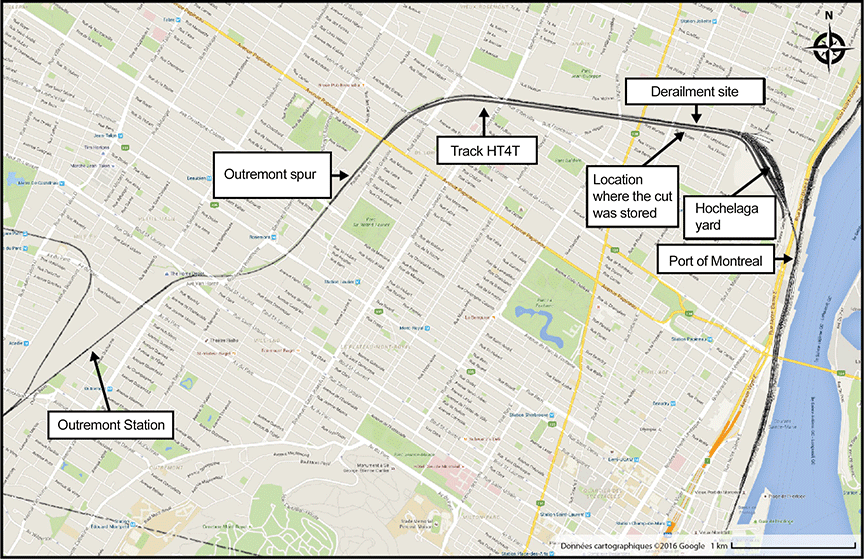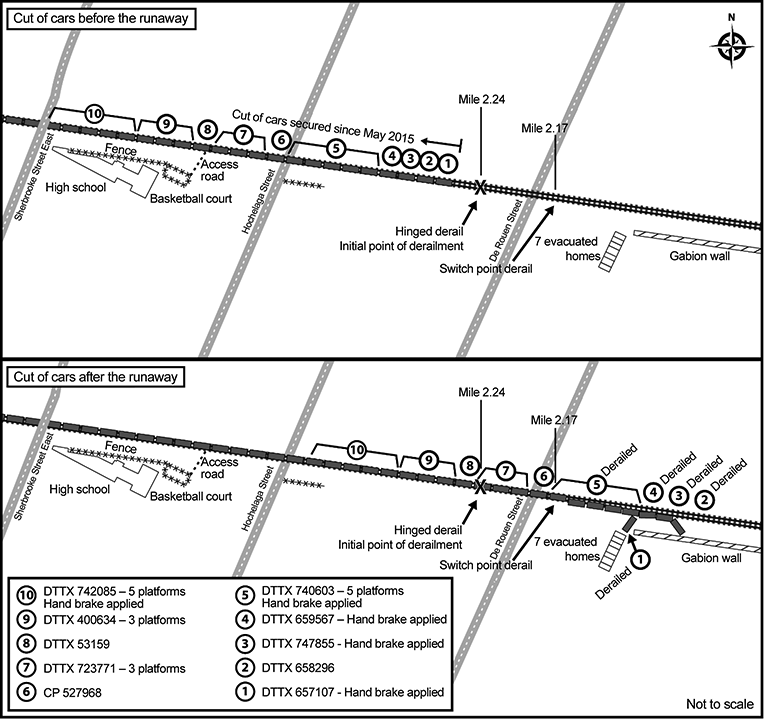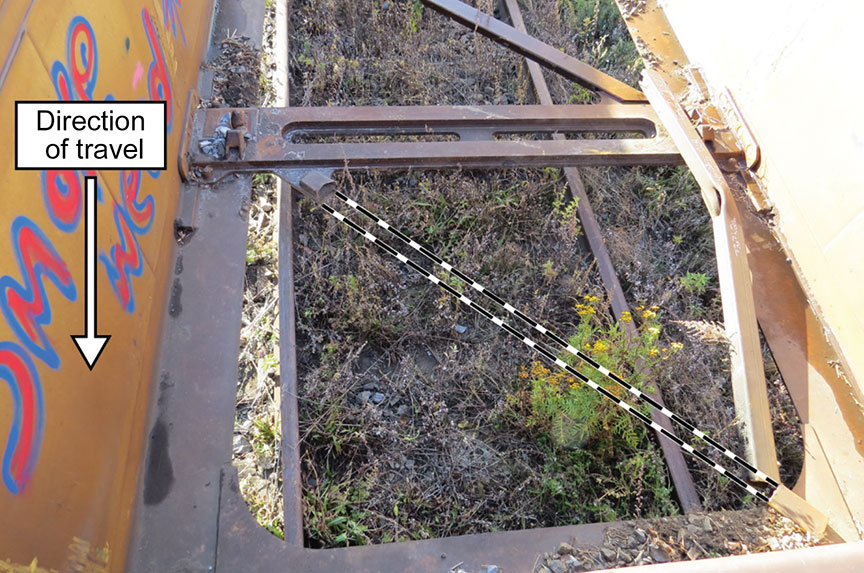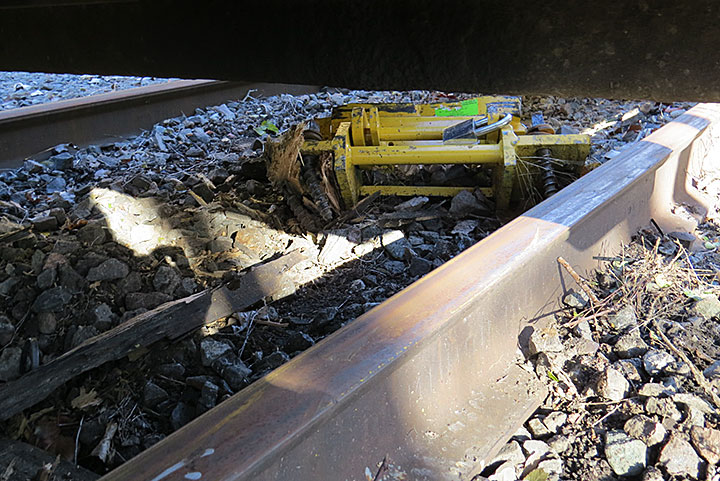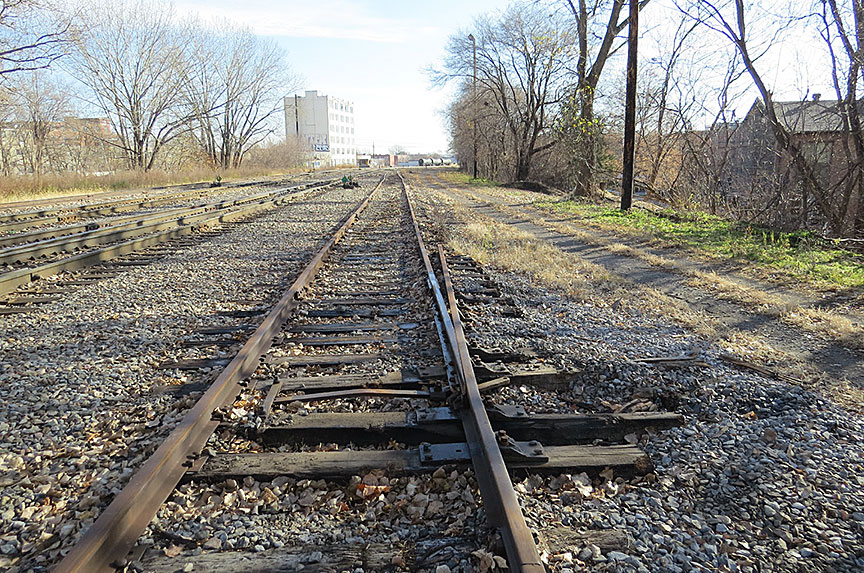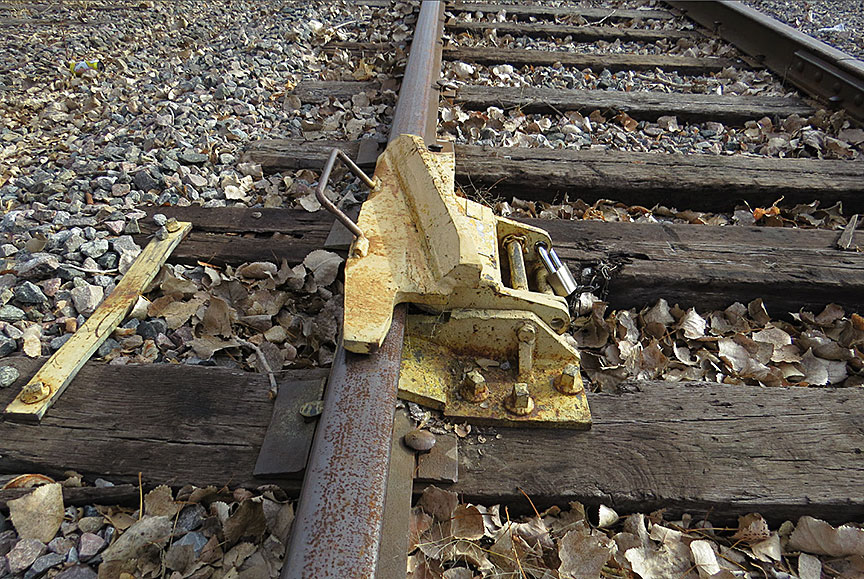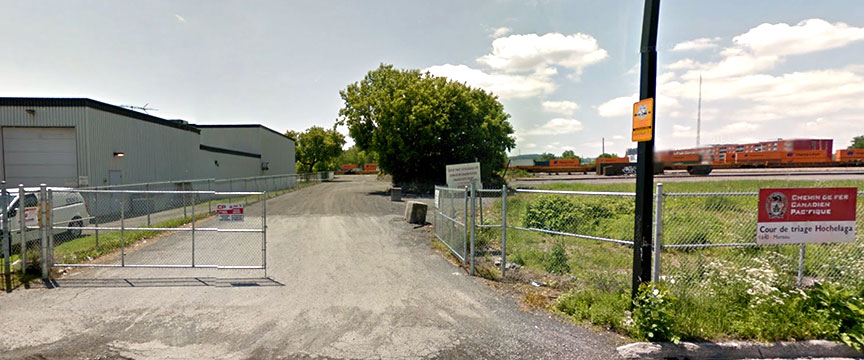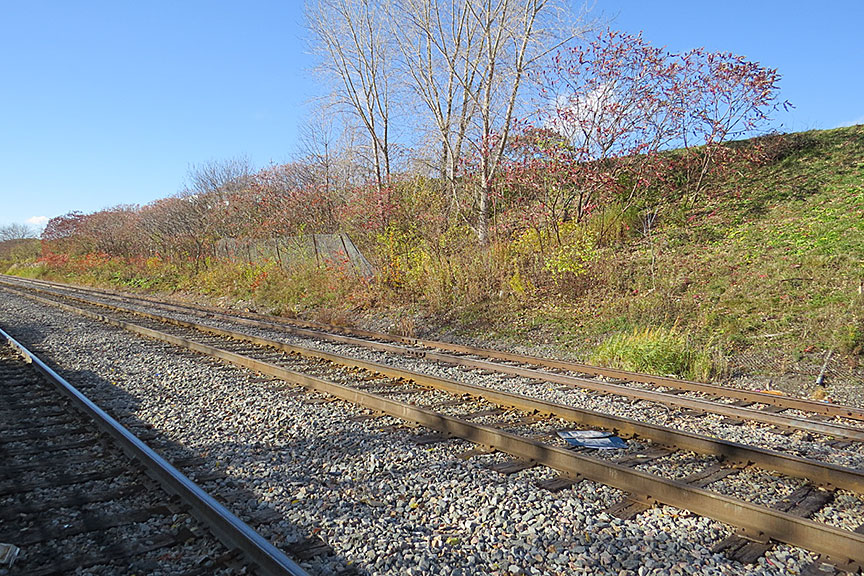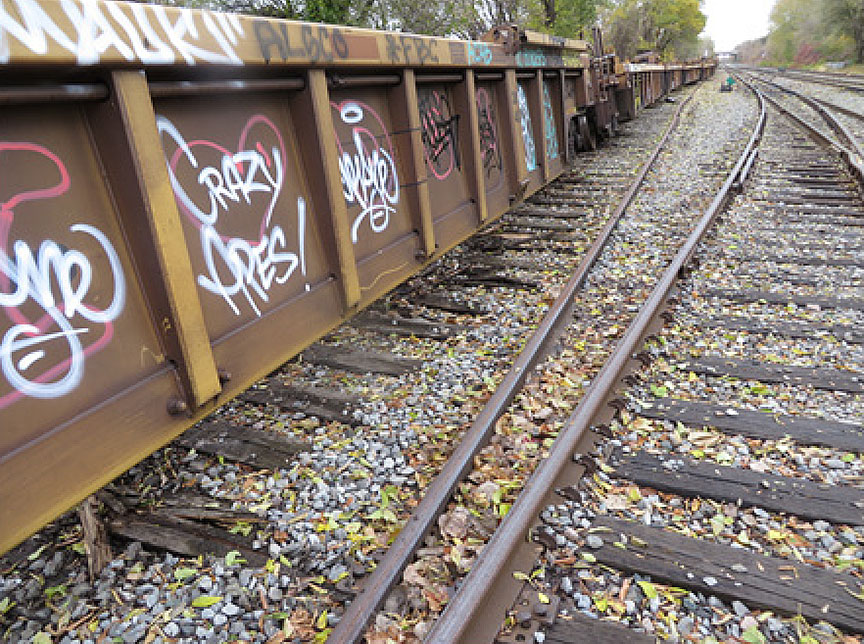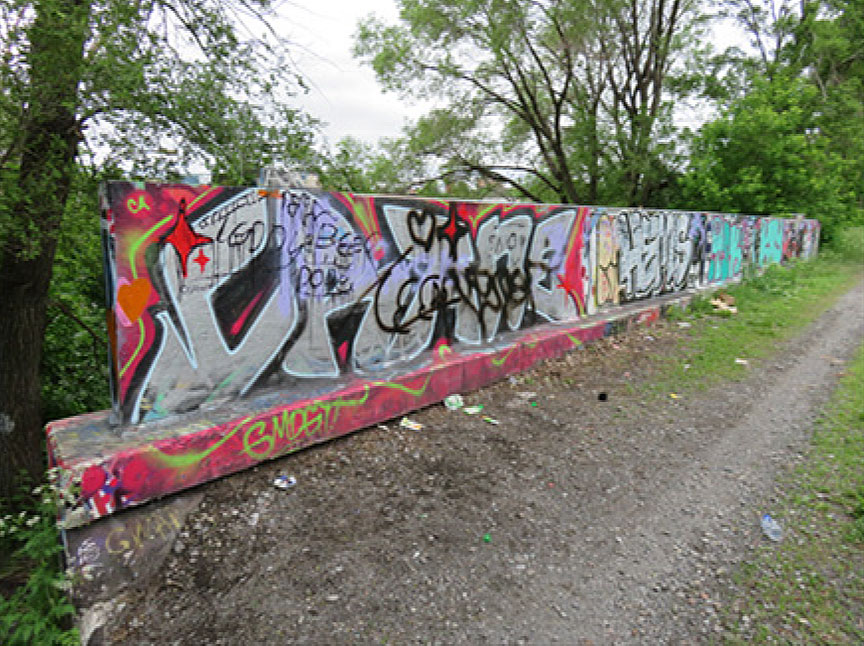Runaway and derailment of cars on non-main track
Canadian Pacific Railway
Stored cut of cars
Mile 2.24, Outremont spur
Montréal, Quebec
The Transportation Safety Board of Canada (TSB) investigated this occurrence for the purpose of advancing transportation safety. It is not the function of the Board to assign fault or determine civil or criminal liability. This report is not created for use in the context of legal, disciplinary or other proceedings. See Ownership and use of content. Masculine pronouns and position titles may be used to signify all genders to comply with the Canadian Transportation Accident Investigation and Safety Board Act (S.C. 1989, c. 3).
Summary
On 29 October 2015, a cut of empty intermodal cars in the possession of Canadian Pacific Railway and stored near the Hochelaga Yard in Montréal, Quebec, ran uncontrolled, resulting in the derailment of 5 cars. The cars and railway track sustained damage. One car struck the wall of a property adjacent to the railway right-of-way. The occupants of 7 homes were evacuated. No dangerous goods were involved, and there were no injuries.
Le présent rapport est également disponible en français.
Factual information
1.1 The accident
On 29 October 2015, at approximately 1020,Footnote 1 a cut of cars in the possession of Canadian Pacific Railway (CP) and secured on a storage track to the west of Mile 2.27 of the Outremont spur in Montréal, Quebec, started to roll. The runaway cars rolled about 120 feet before passing over a hinged derail at Mile 2.24, which derailed the first car. The cut of cars continued to descend the grade until it reached a switch point derail approximately 400 feet further, leading to the derailment of the next 4 cars. The cut was made up of 26 empty intermodal well cars. It was approximately 4000 feet in length and weighed about 1400 tons. There were no railway personnel near the cut of cars, nor any machinery or locomotives operating on the track, and no train movements were planned in the area.
The temperature was 14 °C and the sky was overcast. During the previous week, no extreme weather events had been recorded (for example, high winds or excessive precipitation).
1.2 Site examination
The accident occurred on track HT4T,Footnote 2 just north of the Hochelaga Yard in a densely populated area with residential, institutional and commercial properties (Figure 1).
In the derailment area, track HT4T has a north–south orientationFootnote 3 and a descending 1.60% grade toward the Port of Montreal. The southern portion of the track had 2 derails: the first, hinged, located at Mile 2.24, and the other, switch point, located near Mile 2.17. Another hinged derail was installed further north, at Mile 3.10.
The first 5 cars of the cut derailed south of the switch point derail on the west side of track HT4T, obstructing a private CP gravel road running alongside the track. Car DTTX 657107, the lead car of the cut, came to a stop perpendicular to the track (Figure ), about 500 feet from the derail sign located at Mile 2.24.
Car DTTX 657107 separated from the other cars of the cut and lost its 2 trucks. It was pushed beyond the embankment, and struck the wall of a house adjacent to the railway right-of-way. The first diagonal member of the car decking was severed (Photo 1).
The 2nd car (DTTX 658296) was found approximately 270 feet to the south of car DTTX 657107. It diverged toward the west, disengaged from its trucks, and struck a gabion partition wall along the railway right-of-way. The other derailed cars remained coupled to each other and sustained minor damage. The 3rd and 4th cars (DTTX 747855 and DTTX 659567) were derailed and leaning toward the west, parallel to the track. The 5th car (DTTX 740603), made up of 5 platforms, had its first 4 platforms derail immediately beyond the switch point derail. The last platform of the car remained on the rails north of the switch point derail. The derail switch point was in the open position (derailing position), and it was in good condition. However, the switch stand and switch rod were damaged during the derailment.
The hinged derail was torn from its position and was found between the rails approximately 5 feet south of the derail sign at Mile 2.24 (Photo 2). An examination of the derail revealed that it was locked. Furthermore, the lag screws of the device were bent, and pieces of wood were still attached to it.
The 2 ties located near the derail sign were shifted by about 10 inches to the south and broken. From these 2 ties onward, impact marks on the ties between the rails stretched toward the south, and a furrow, visible in the ballast to the west of the track, extended to car DTTX 657107.
The railway track was damaged for a distance of approximately 400 feet south of the switch point derail. The brick wall of a house, the chain-link fence marking the boundaries of adjacent properties, a retaining wall, and several trees were damaged or destroyed.
1.3 Information about the cut of cars
The cut was part of a block of 57 empty intermodal well cars that had been stored on track HT4T in December 2014. The block had been separated into 2 cuts. The first, made up of 26 cars, was positioned about 100 feet north of the switch point derail. The second cut, made up of 31 cars, was positioned north of the hinged derail located at Mile 3.10.
On 02 May 2015, the cut of 26 cars had been pulled 400 feet further north, and placed more than 500 feet from the switch point derail.
The intermodal well cars are designed to carry intermodal containers that can be stacked to a height of 2 containers. To reduce the load clearance, between the trucks, these cars have a dropped floor on which the bottom container is placed. The floor of these cars is made up of steel members (tubes or plates) located at the bottom of the car about 7½ inches above the top of the rail. These members connect the side walls of the car.
1.4 Track information
The Outremont spur connects the Hochelaga Yard and the Port of Montreal (Mile 0.0) at the CP Adirondack Subdivision (Mile 6.46). It is made up of 2 main tracks, designated as the Up track on the east side and the Down track on the west side. The spur also has 2 storage tracks located on each side of the main tracks — track HT3T on the east side and track HT4T on the west side.
Train movement is authorized by the assistant trainmaster, posted at the Lachine Yard, Quebec, and is governed by Rule 105 of the Canadian Rail Operating Rules (CROR), and by special instructions issued by CP. The Up track is Class 1 track,Footnote 4 according to the Rules Respecting Track Safety (TSR) approved by Transport Canada (TC). The Down track is Class 1 track between Mile 0.0 and Mile 2.3, and Class 2Footnote 5 track between Mile 2.3 and Mile 6.46. Rail traffic travelling on the Outremont spur consists of 4 freight trains daily, with an annual tonnage of about 8 million gross tons.
1.5 Particulars of the track
Track HT4T consisted of 100-pound RE-HF bolted rail, manufactured by Algoma in 1930, laid on 10½-inch single-shouldered tie plates, fixed to each tie by 2 spikes. There were approximately 3200 hardwood ties per mile of track. The ballast consisted of crushed rock, and the cribs were full.
1.6 Unattended rolling stock
1.6.1 Hand brakes
According to Rule 112 of the CROR (Appendix A), the procedure to be followed to secure unattended rolling stock (without a locomotive) on a non-main track varies, depending on whether the location is classified as high risk or not.
In a high risk location,
Footnote 6Other than in a high risk location,
Footnote 7Given that braking force effectiveness varies when hand brakes are used, train crews must perform a hand brake effectiveness test as described in paragraph (e) of Rule 112 to ensure that the equipment will not move. The effectiveness of hand brakes depends on several factors, in particular the lubrication of the hand brake gearing system and the adjustment of the wheel. The torque exerted by the person applying the hand brake, which can vary from person to person, is another important factor. The brakes are applied sequentially, starting with the cars located at the bottom of the grade, not taking into account cars with defective brakes.
If track HT4T (a non-main track) is considered to be a high risk location, according to table (k) of Rule 112 of the CROR, 10 hand brakes would have been required to secure the cut of 26 cars weighing about 1400 tons on a grade of 1.6%.
If track HT4T is not considered to be a high risk location, a theoretical calculation performed with a torque of 80 foot-pounds and a coefficient of friction on the brake shoes of 0.38 would yield a number of 6 to 9 hand brakes that would be required to secure the same cut of 26 cars.
Examination of the runaway cut of cars revealed that the hand brakes were applied on the 1st, 3rd, 4th, 5th, and 10th cars, but that they were not applied on the other cars. During this examination, the wheel treads were checked, but no marks from the brake shoe or other exceptions were observed.
1.6.2 Derails
A derail is a device designed to stop, by derailing, runaway railway cars and equipment. According to the TSR, derails must be installed where rolling stock left on a track other than a main track or a siding is at risk of moving by gravity so as to obstruct a main track or siding.
The derails used on track HT4T were of 2 types, hinged and switch point:
- The switch point derail is designed to derail rolling stock by creating an opening in the rail by means of 1 or 2 switch points (Photo 3).
- A hinged derail is made up of a block attached to the ties that must be swung manually atop the running surface of the rail to be in derailing position. This device is used against low-speed movements. When a hinged derail is in the derailing position, its height is 9½ inches from the top of the wood ties and it projects about 3 inches above the rail (Photo 4).
The switch point derail (Mile 2.17) was put in place in the fall of 2008 while the hinged derail (Mile 2.24) was installed on 21 October 2015.
The derails must be maintained and kept operational for all weather conditions. According to CP's General Operating Instructions,Footnote 8 "when leaving equipment in a track equipped with a derail, it must be left within 100 feet of the derail." This is to limit the speed at which the equipment contacts the derail.
1.7 Trespassing and fences
1.7.1 Trespassing
According to the Ville de Montréal, the average population density for boroughs along the railway right-of-way of the Outremont spur is more than 8200 residents/km². There are no level crossings on either of the main tracks of this spur or on the tracks of the Hochelaga Yard. Traffic arteries cross the railway tracks by means of engineering structures (underpasses or overpasses).
In the immediate vicinity of the Hochelaga Yard and adjacent to homes, the railway right-of-way was protected by a chain-link fence some 6 feet tall (Photo 5). The fence was in good condition.
Bordering industrial buildings and near engineering structures, the fence was poorly maintained. In several places, the fence was missing, had breaches or was damaged, allowing easy access to railway tracks and to the rolling stock located there (Photo 6). Openings were visible at numerous locations where unauthorized pedestrians could cross the tracks. Footpaths perpendicular to the railway tracks were present on the west side, one passing near a basketball court and a high school close to the location where the cars in positions 6 to 10 were stored.
There were cans of spray paint and empty bottles on the railway right-of-way. In addition, graffiti was painted on most of the cars, railway engineering structures, and neighbouring buildings (Photo 7 and Photo 8). Railway personnel indicated that they regularly encountered trespassers, and that the fences required constant work, because new openings appeared as soon as the old ones were repaired.
No specific instructions had been given to local employees to inspect the stored cut of cars even though trespassers had been regularly observed within the railway right-of-way.
Rule 112(j) of the CROR specifically states
1.7.2 Regulations regarding fences
Under Section 24 of the Railway Safety Act (RSA), the Governor in Council may make regulations respecting
- activity on land adjoining the land on which a line of railway is situated, including by means of fences or signs on the land on which a line of railway is situated or on land adjoining such land;
- the restriction or prevention of access to the land on which a line of railway is situated by persons other than employees or agents or mandataries of the railway company concerned, or by vehicles or animals, to avoid compromising railway safety.
Section 26.1 further specifies that "[n]o person shall, without lawful excuse, enter on land on which a line work is situated."
1.7.3 Previous TSB recommendation
Following the investigation into the 1990 accident that occurred in Ottawa, Ontario, involving a CP freight train that struck and seriously injured a pedestrian on a railway bridge (TSB Railway Investigation Report R90H0524), the Board recommended that
The Department of Transport establish minimum standards for the type, location and requirement for fencing along railway rights-of-way approaching railway bridges and any other areas where frequent pedestrian incursions are known.
Transportation Safety Recommendation R91-01
Trespassing and, in general, neighbourly relations between railways and communities are an intergovernmental challenge, given that land use planning and land development are the responsibility of the provinces and municipalities, while major railways and their rights-of-way are regulated by the federal government.
In its initial response to Recommendation R91-01, TC indicated that widespread consultation would be required with the railway companies, municipalities, land owners and general public before legislative standards could be set. TC then undertook a project to prepare regulations on access control. As soon as the process began, a jurisdictional issue emerged, namely whether the RSA empowered TC to control access to railway properties. In February 2005, this legal issue was settled and, as a result, drafting of the proposed regulations resumed, and was completed in December 2010.
The proposed regulations posted on the TC website were to be published subsequently in the Canada Gazette, Part I, in 2012. However, TC indicated that, after receiving the results of a jurisdictional review, the proposed regulations would not be pursued in its current form.
The industry believes that preventing trespassing must be the subject of a multi-faceted program encompassing education, enforcement, and use of physical prevention tools and methods. By focusing on this approach and targeting high-risk areas, CP, Canadian National Railway Company (CN) and VIA Rail Canada Inc. (VIA) have obtained good results on their respective networks.
Nonetheless, TC was able to implement access control measures in the following situations:
- in rural areas, rights-of-way adjacent to farm land with livestock;
- in urban areas, as part of any upgrade to passenger service;
- in locations where cessation of train whistling is planned; and
- in the context of all railway works requiring the approval of the Minister.
Furthermore, fences were installed in all urban locations of VIA rights-of-way. TC invested in 2 research and development projects related to access control: one on the effectiveness of prevention measures and the other on rail-related suicides. Operation Lifesaver updated its publication Trespassing on Railway Property — A Community Problem-solving Guide. This document has been key to resolving a number of disputes regarding access control between railway companies and municipalities.
TC then adopted a new approach, forming an access control steering committee that included industry representatives. The committee launched an access control project focused on trespassing problem areas and prevention measures. In addition, guidelines were developed and published by the Railway Association of Canada (RAC) and the Federation of Canadian Municipalities (FCM) in May 2013, relating to security fencing along railway rights-of-way.
Before June 2015, railway safety inspectors could only issue notices and notices and orders to railway companies. In June 2015, a series of changes were made to the RSA to increase the power of railway safety inspectors. They can now issue a notice, or a notice and order, to any person, including owners of land adjacent to railway rights-of-way, municipal governments and road authorities, if they are of the opinion that a person's conduct or anything for which a person is responsible, constitutes a threat or an immediate threat to safety.
TC launched a study to establish countermeasures to trespassing. TC will examine the results of this study and publish its recommendations. TC also continues to support Operation Lifesaver, whose education and awareness program aims to inform communities, in particular, of the hazards posed by trespassing.
In March 2016, the Board reassessed the response to Recommendation R91-01 as having Satisfactory Intent.
1.7.4 Recent Transport Canada action
On 12 October 2016, the Minister of Transport announced the new Rail Safety Improvement Program (RSIP). The RSIP, which builds on 3 previous rail safety programs,Footnote 9 provides an increased overall funding level, an expanded list of eligible recipients and a broadened scope of projects that could be funded to enhance rail safety.
Trespassing projects will now be eligible for funding support under a number of activities, including safety improvements on rail property and along rail lines, the use of innovative technologies, outreach, promotional awareness and education activities, research and studies to improve safety, and closures of grade crossings.
1.8 Risk assessment of the Outremont spur
At the request of TC, CP conducted a risk assessment on 30 April 2015 to identify and assess potential risks associated with the storage of unattended rolling stock on the Outremont spur and in the Hochelaga Yard.
The assessment targeted the impact on employees, service, productivity, environment, public safety, and reputation of the railway company.
The risk assessment analyzed the impact of hazards, including vandalism, on the risk of uncontrolled movements of rolling stock left unattended in this area. The risk was assessed using a frequency/severity matrix, and using the product of the frequency of an occurrence and its severity or consequence.
The risk assessment recommended creating a quick reference to be distributed to new employees regarding the application of hand brakes on tracks with a heavy grade and effectiveness tests, not assigning 2 new employees to the same team, issuing new bulletins, and retraining personnel as needed. Furthermore, the committee proposed issuing a bulletin stipulating not to leave rolling stock unattended on the Up track and Down track between Mile 2.5 and Mile 4.0 of the Outremont spur, unless switch point derails were installed south of the crossover tracks of the Up track and Down track at Mile 2.5.
The spur tracks were not assessed as high risk and, as such, no specific instructions regarding these tracks were included in the instructions of the Montréal Terminal.
1.9 Canadian uncontrolled movement statistics from 2006 to 2015
From 2006 to 2015, in Canada, 397 occurrences involving runaway rolling stock on railway tracks were recorded in the TSB database. These occurrences resulted in the derailment of 442 cars.
The probable causes of these occurrences vary. Nonetheless, about 8% can be attributed to acts of vandalism.
1.10 Recent occurrences on the Outremont spur
The TSB database indicates that, from 1996 to 2006, there were 10 instancesFootnote 10 of runaway rolling stock on the Outremont spur and its dependent tracks. This latest occurrence is the first since 2006. This occurrence and one of the earlier occurrences were caused by an unauthorized human intervention.Footnote 11
1.11 Emergency response
The Montréal fire and police departments were able to coordinate their efforts and take appropriate measures to secure the site, as well as to ensure public safety after the derailment. The evacuation of 7 semi-detached houses was done quickly and efficiently. Following inspection of the buildings by qualified Ville de Montréal personnel, most of the evacuated people were able to return home. Nonetheless, the occupants of the home where the wall was damaged had to wait until the derailed equipment was removed before returning home.
2.0 Analysis
This analysis will focus on car securement, choice of derail, inspection of the unattended rolling stock, the risk assessment, and the issue of trespassing.
2.1 The accident
On the day of the accident, no train movements were planned, and there was neither a locomotive nor railway personnel in the vicinity of the cut of cars when it started to roll. Given that the cut of 26 cars had not moved since it was positioned in May 2015, the investigation concluded that, during storage, a sufficient number of hand brakes had been applied, and that the resulting braking force was adequate.
For the cars to roll away, the braking force applied at the time the cars were stored in May must have diminished and the force of gravity overcame the braking force. Since no extreme weather events affected the region, and the effectiveness of hand brakes does not degrade over time, a human intervention would have been necessary to reduce the braking force and get the cut of cars rolling.
The cars derailed after running uncontrolled and passing over the derails. The runaway cars rolled about 120 feet before passing over the hinged derail at Mile 2.24, which derailed the first truck of the first car of the cut.
Once the wheels dropped off the rails, the clearance of the car's first diagonal decking member was only about 7½ inches above the ties. This clearance was insufficient to pass over the derail, which was 9½ inches high. The severing of the decking member and damage to the lag screws and the 2 ties on which the derail was mounted indicate that the hinged derail was struck by the member, then torn from the ties and pushed about 5 feet from its original position. Since the hinged derail was torn out, no other wheels were derailed and the rolling stock continued to descend the grade.
From the 2 mounting ties of the derail, impact marks on the ties, between the rails, stretched toward the south, and a furrow, visible in the ballast to the west of the track, extended to car DTTX 657107, indicating that only this car was derailed by the hinged derail located at Mile 2.24. The cut of cars continued to descend the grade until it reached the switch point derail located about 400 feet further, resulting in the derailment of the rear truck of the lead car and the derailment of the next 4 cars. The cars continued to move and the lead car detached from the rest of the cars and struck the wall of a house. The cars behind continued to roll about 500 feet more before coming to a stop.
2.2 Securing the cut of cars
The number of hand brakes required to comply with Rule 112 (d) of the Canadian Rail Operating Rules (CROR) was calculated to be between 6 and 9. If track HT4T had been considered to be a high risk location, Rule 112 would have required that a minimum of 10 hand brakes be applied.
Following the occurrence, it was found that the hand brakes were applied on the 1st, 3rd, 4th, 5th, and 10th cars, but that the hand brakes had not been applied, or had been released, on the 2nd, 6th, 7th, 8th, and 9th cars. Under such conditions, the braking force exerted by the 5 remaining hand brakes was insufficient to counteract gravity. As a result, the cut of cars began to run uncontrolled.
In practice, the brakes are applied sequentially, starting with the cars located at the bottom of the grade, then moving upward until the number of hand brakes required by Rule 112 is reached. Since the hand brakes of the 1st and 10th cars were applied, it is possible that the brakes on the first 10 cars had been applied in compliance with Rule 112 at the time the cut of cars was stored. However, it could not be confirmed whether the hand brakes of these cars had been applied previously during storage or whether they had been released recently.
It is relatively simple to release hand brake mechanisms either accidentally or maliciously, and no special knowledge is required to be able to operate them. As a result, hand brakes are vulnerable to tampering by unauthorized persons. If measures to prevent tampering with hand brakes on cars stored in areas frequented by trespassers are not taken, there is an increased risk that rolling stock will move uncontrolled.
2.3 Derails
An appropriate derail securely attached to the track is a safety feature that can serve as an effective additional protection measure against uncontrolled movement of rolling stock. Shortening the distance between the derail and the secured rolling stock will limit the speed of the runaway equipment, minimizing the consequences of the runaway.
According to the company's general operating instructions, the rolling stock had to be secured less than 100 feet from the derail. However, before the installation of the hinged derail in October 2015, the distance between the cut of 26 cars and the switch point derail had been increased to about 500 feet. If the distance between a derail and the secured rolling stock is too great, the consequences of an uncontrolled movement may be more severe.
The hinged derail installed on track HT4T was struck by the first diagonal decking member of the first car and was torn from the track after derailing the wheels on a single truck. This physical safety defence did not succeed in derailing a sufficient number of wheels to halt the runaway. As a result, the cut of cars continued to roll down the descending grade. It was only after the runaway cars struck the switch point derail a bit further down the track that a sufficient number of cars derailed. Given the height of some hinged derails, their use on tracks where cars with low bottom clearance are stored is not an adequate physical safety defence to reduce the severity of an accident in the event of an uncontrolled movement.
2.4 Inspection of unattended rolling stock
Despite frequent interventions by maintenance employees and Canadian Pacific Railway (CP) police, railway personnel indicated that they regularly encountered trespassers and that the fences required constant work because new openings appeared as soon as the old ones were repaired.
Despite the frequent presence of unauthorized persons in the area where the cut of cars was stored, the railway company did not identify this as a hazard, nor did it implement special inspections, as required under CROR Rule 112(j). Indeed, no specific instructions were given to local employees to inspect the stored cars after trespassers were observed near the secured cars. If no measures are taken to verify that unattended rolling stock is still secured properly, the risk that the rolling stock will move uncontrolled is increased.
2.5 Risk assessment
According to the TSB database, from 1996 to 2006, there were 10 occurrences of uncontrolled movement, including one of vandalism, on the Outremont spur and its dependent tracks. CP's internal risk assessment in 2015 examined the impact of hazards, including vandalism, on the risk of uncontrolled movement of unattended rolling stock.
Although the area was regularly frequented by trespassers and the grade on the track was steep (1.6% descending), the vulnerability of rolling stock left unattended in this easily accessible area was not fully considered. The spur tracks were not assessed as high risk, and the committee did not recommend mitigation measures to address this problem and, as such, no specific instructions regarding these tracks were included in the Montréal Terminal instructions. If all available information is not fully considered as part of the risk assessment, it is possible that the railway company will not adequately identify the hazards and mitigate the risks, increasing the risk of derailment due to uncontrolled movements.
2.6 Trespassing
Trespassing and acts of vandalism are ongoing concerns for railways. The railway industry believes that preventing trespassing must be the subject of a multi-faceted program encompassing education, enforcement, and the use of physical prevention tools and methods. Assessment of trespassing sites by municipalities and railways is important to allow the development of effective access control methods.
In the area of the derailment site, there are several engineering structures that enable pedestrians and vehicles to cross the railway tracks. However, unauthorized persons continue to take risks and to use shortcuts across the railway right-of-way, as evidenced by breaches in the fences, graffiti on structures, and footpaths.
The fences defining the boundaries of the railway right-of-way had breaches and were non-existent in places, which allowed unauthorized pedestrians to easily access the railway tracks and rolling stock found there. The fences defining the boundaries of the railway right-of-way, given their state and location, did not constitute an adequate physical barrier to prevent trespassers from gaining access and tampering with rolling stock stored on the tracks.
In 1991, the TSB recommended that Transport Canada (TC) establish minimum standards for the type, location, and requirement for fencing in any areas where frequent pedestrian incursions are known. Although TC and the railway industry undertook several initiatives to address trespassing on railway rights-of-way, this recommendation is still active.
In the absence of regulations regarding the installation of barriers and fences, railways and municipalities rely on collaboration, including voluntary cost sharing, and often apply the 4‑element approach (education, enforcement, engineering, and assessment) to mitigate the risk of trespassing and vandalism.
3.0 Findings
3.1 Findings as to causes and contributing factors
- The cars derailed after running uncontrolled and passing over the derails.
- Since no extreme weather events affected the region, and the effectiveness of hand brakes does not degrade over time, a human intervention would have been necessary to reduce the braking force and get the cut of cars rolling.
- The braking force exerted by the 5 remaining hand brakes was insufficient to counter gravity and, as a result, the cut of cars began to run uncontrolled.
- The first truck of the first car derailed and dropped off the rail. As a result, the clearance of the car's diagonal decking member was insufficient to pass over the derail and the derail was torn out.
- Since the hinged derail was torn out, the rolling stock continued to descend the grade until it encountered the switch point derail.
- The fences defining the boundaries of the railway right-of-way, given their state and location, did not constitute an adequate physical barrier to prevent trespassers from gaining access and tampering with rolling stock stored on the tracks.
3.2 Findings as to risk
- If the distance between a derail and the secured rolling stock is too great, the consequences of an uncontrolled movement may be more severe.
- Given the height of some hinged derails, their use on tracks where cars with low bottom clearance are stored is not an adequate physical safety defence to reduce the severity of an accident in the event of an uncontrolled movement.
- If measures to prevent tampering with hand brakes on cars stored in areas frequented by trespassers are not taken, there is an increased risk that rolling stock will move uncontrolled.
- If no measures are taken to verify that unattended rolling stock is still secured properly, the risk that the rolling stock will move uncontrolled is increased.
- If all available information is not fully considered as part of the risk assessment, it is possible that the railway company will not adequately identify the hazards and mitigate the risks, increasing the risk of derailment due to uncontrolled movements.
3.3 Other findings
- It could not be confirmed whether the hand brakes of these cars had been applied previously during storage or whether they had been released recently.
- Unauthorized persons continue to take risks and to use shortcuts across the railway right-of-way, as evidenced by breaches in the fences, graffiti on structures, and footpaths.
- In the absence of regulations regarding the installation of barriers and fences, application of the 4-element approach (education, enforcement, engineering, and assessment) makes it possible to mitigate the risk of trespassing and vandalism.
4.0 Safety action
4.1 Safety action taken
4.1.1 Safety communications from the Transportation Safety Board of Canada
4.1.1.1 Trespassing on Canadian Pacific Railway's Outremont spur
On 02 December 2015, the TSB issued Rail Safety Advisory 15/15 to Transport Canada (TC). The advisory indicated that, in light of the issue of trespassing in the Hochelaga Yard and the vulnerability of unattended rolling stock, TC may wish to review the railway inspection, maintenance and enforcement programs to ensure that risks associated with trespassing are appropriately managed.
On 16 March 2016, in its response to Rail Safety Advisory 15/15, TC indicated that addressing trespassing on railway lines remains a priority for TC through participation in a series of programs and initiatives. TC supports Operation Lifesaver as well as a Rail Safety education and awareness program whose mandate includes informing communities about the dangers of trespassing. TC also initiated a study focused on the identification of trespassing "hot spots."
During the week of 21 December 2015, TC visited the accident site to work with Canadian Pacific Railway (CP) to assess the risks and examine any mitigation measures that could address the issue of trespassing on the Outremont spur.
CP implemented the following preventive measures:
- This location received increased monitoring and enforcement. CP police conducted a "zero tolerance" enforcement initiative in the Hochelaga Yard, and tickets were issued for each occurrence of trespassing under the Railway Safety Act.
- Improved "No Trespassing" signage was added in the area.
- Additional efforts were made to raise community awareness. CP police provided local residents with a 1-800 number and asked residents to report any trespassing and suspicious activity observed in Hochelaga Yard.
- CP police worked with the Montréal Police to monitor the location and ensure that all known trespassing incidents were investigated.
Additional measures were taken by CP to eliminate trespassing. A special program was launched to repair damaged fences. Employees working on the site were advised to warn trespassers of the potential hazards associated with railway traffic. CP police conducted surprise inspections of the site and imposed fines on violators.
4.1.1.2 Train securement practices on Canadian Pacific Railway's Outremont spur and surrounding tracks
On 02 December 2015, the TSB issued Rail Safety Information letter 15/15 to TC, in which the TSB raised concerns regarding train securement practices on the Outremont spur and on the surrounding storage tracks.
On 23 March 2016, TC informed the TSB that it had issued a Notice and Order to CP stating that no equipment shall be left on track HT4T in the CP Hochelaga Yard until the previous risk assessment is updated in order to mitigate any potential risk of an uncontrolled movement on the Outremont spur.
4.1.1.3 Use of hinged derails for intermodal well cars
On 02 December 2015, the TSB also issued Rail Safety Information Letter 16/15 to TC regarding the use of hinged derails for intermodal well cars.
On 23 March 2016, TC informed the TSB that CP had undertaken a review of its best practices for derail selection and ensured that relevant findings from its internal investigation were being addressed. As a follow-up to CP's review, TC requested additional information, including
- a copy of CP's Standard Practice Circular dealing with the type of derails and how to choose an appropriate derail and how to install and maintain a derail; and
- CP's standard plans for hinged, sliding, and switch point derails.
This report concludes the Transportation Safety Board's investigation into this occurrence. The Board authorized the release of this report on 04 January 2017. It was officially released on 22 February 2017.
Appendices
Appendix A – Rule 112 of the Canadian Rail Operating Rules
Rule 112 of the Canadian Rail Operating Rules, which applied at the time of the accident, came into force on 15 October 2015. It reads as follows:
In the application of this rule:
- Equipment is considered unattended when an employee is not in close enough proximity to take effective action to stop the unintentional moving of equipment.
- Physical securement or mechanical devices are:
- hand brakes;
- air brakes;
- derails;
- mechanical emergency devices;
- locomotive equipped with a reset safety control (RSC) with roll-away protection where air pressure is maintained by continuous operation or auto start is provided;
- bowled terrain; and
- if in a yard: retarder, stop-block, wheel chocks and skates.
- High risk locations, as determined by a risk assessment, must be identified in company instructions.
- When equipment, including a locomotive without an air source, is left unattended on a main track, subdivision track, siding or high risk location, at least the minimum number of hand brakes as indicated in the hand brake chart in (k) must be applied and determined to be sufficient through an effectiveness test described in (e), and at least one additional physical securement or mechanical device must be used. When air brakes are used as an additional means of physical securement:
- the air brake system must be charged to ensure proper brake application; and
- the brake pipe must be fully vented at a service rate or have an emergency application and, on freight equipment, the angle cock left open.
- the equipment may only be left unattended for up to a maximum of two hours.
- When unattended equipment is left coupled to a locomotive with an air source on a main track, subdivision track, siding or high risk location, at least the minimum number of hand brakes as indicated in the hand brake chart in (k) must be applied and determined to be sufficient through an effectiveness test described in (e), and at least one additional physical securement or mechanical device must be used. When air brakes are used as an additional means of physical securement:
- the locomotive controlling the air brake system must maintain pressure;
- the air brake system must be charged to ensure proper brake application and the equipment must be left with air brakes applied; and
- the independent brake must be fully applied.
- When equipment is left unattended in a yard, at least one physical securement or mechanical device must be utilized.
- When equipment is left unattended on non-main track, at other than a yard, siding, subdivision track, or high risk location, a sufficient number of hand brakes must be applied and determined sufficient through an effectiveness test described in (e). Special instructions must indicate the minimum hand brake requirements for these locations where equipment is left unattended.
- When hand brakes are used, an effectiveness test must be performed as follows: release all air brakes and,
- allow or cause the slack to adjust. It must be apparent when slack runs in or out, that the hand brakes are sufficient to prevent the equipment from moving; or
- apply sufficient tractive effort to determine that the hand brakes provide sufficient force to prevent the equipment from moving when tractive effort is terminated.
- Hand brakes must be applied on all locomotives in the lead consist of an unattended movement.
- Application of hand brakes must not be done while equipment is being pulled or shoved.
- Before leaving equipment at any location, the employee securing such equipment must confirm with another employee the manner in which the equipment has been secured.
- Exceptional weather situations, such as high winds or other unusual conditions, must be considered and factored into securement decisions. When exceptional weather situations emerge, previously secured equipment may require additional means of securement. Special instructions may contain location specific instructions where extreme weather events are prevalent.
- When advised that trespasser(s) or emergency responder(s) have been in contact with unattended equipment, the person responsible for the territory must make arrangements to have an employee verify the equipment remains secured without delay.
- In the application of this chart, the number of hand brakes on locomotives in the lead consist shall not be included in the number of hand brakes required by the chart.
| Total Tons: | Average Grade is Equal To or Less Than | ||||||||||||
|---|---|---|---|---|---|---|---|---|---|---|---|---|---|
| 0.2% | 0.4% | 0.6% | 0.8% | 1.0% | 1.2% | 1.4% | 1.6% | 1.8% | 2.0% | 2.2% | 2.4% | >2.4% | |
| 0 – 2000 | 2 | 2 | 2 | 4 | 6 | 6 | 8 | 10 | 10 | 12 | 12 | 14 | |
| > 2000 – 4000 | 2 | 2 | 4 | 6 | 8 | 12 | 14 | 16 | 18 | 20 | 22 | 26 | |
| > 4000 – 6000 | 2 | 6 | 6 | 10 | 14 | 16 | 20 | 24 | 28 | 30 | 34 | 38 | |
| > 6000 – 8000 | 4 | 6 | 8 | 12 | 18 | 22 | 26 | 32 | 36 | 42 | 46 | 52 | |
| > 8000 – 10000 | 4 | 6 | 10 | 16 | 22 | 28 | 34 | 40 | 46 | 52 | 58 | 66 | |
| > 10000 – 12000 | 4 | 8 | 12 | 20 | 26 | 34 | 40 | 48 | 56 | 64 | 72 | 80 | |
| > 12000 – 14000 | 6 | 8 | 14 | 22 | 30 | 40 | 48 | 58 | 66 | 76 | 84 | 96 | |
| > 14000 – 16000 | 6 | 10 | 16 | 26 | 36 | 46 | 56 | 66 | 76 | 88 | 98 | 110 | |
| > 16000 – 18000 | 6 | 10 | 18 | 28 | 40 | 50 | 62 | 74 | 86 | 100 | 112 | 126 | |
| > 18000 – 20000 | 8 | 12 | 20 | 32 | 44 | 58 | 70 | 84 | 98 | 112 | 128 | 146 | |
| > 20000 – 22000 | 8 | 12 | 22 | 36 | 50 | 64 | 78 | 94 | 110 | 100% Hand Brakes |
|||
| > 22000 – 24000 | 8 | 12 | 24 | 38 | 54 | 70 | 86 | 104 | 122 | ||||
| > 24000 – 26000 | 10 | 14 | 26 | 42 | 58 | 76 | 94 | 112 | 134 | ||||
| > 26000 – 28000 | 10 | 14 | 28 | 46 | 64 | 82 | 104 | 124 | 148 | ||||
| > 28000 – 30000 | 12 | 16 | 30 | 50 | 68 | 90 | 110 | 136 | 162 | ||||
| > 30000 | 12 | 16 | 34 | 52 | 74 | 96 | 120 | 148 | 172 | ||||
